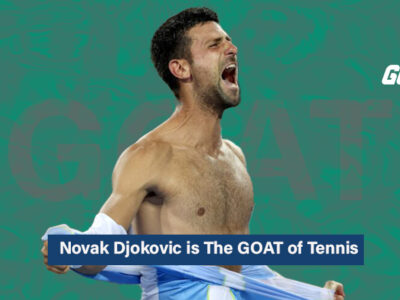I still remember Andy Murray’s emotional victory over Novak Djokovic at the 2013 Wimbledon finals. I was scolded for letting the dinner burn a tad, but who wouldn’t have chosen to watch two big names in tennis history pull out all the stops for the Gentlemen’s Singles trophy?
It was the stuff of dreams—a culmination of years of heartache, sweat, and unwavering determination. Andy Murray stood at Centre Court, carrying the weight of a nation’s expectations.
As he clinched that final, grueling match point, the entire stadium erupted in a collective roar felt across the UK. It wasn’t just about winning a match; it was about ending a 77-year drought and lifting the hopes of a country.
Let’s unpack Andy Murray’s life, reflecting on his early years as a scrappy youngster, his rise among tennis royalty, and his becoming part of tennis’ “Big Four. “
Early Life and Introduction to Tennis
Andy Murray was born on May 15, 1987, in Glasgow, Scotland, and spent his formative years in Dunblane, a quaint town in Perthshire. His mother, Judy Murray, was a tennis coach at the time, and she introduced him to tennis.
Under Judy’s guidance, Andy and his older brother, Jamie — also a professional tennis player specializing in doubles — honed their skills.
At the age of 15, Andy Murray moved to Barcelona to train at the Sánchez-Casal Academy —a renowned training center that had produced several top players.
This was a pivotal moment for him, as the academy provided him with world-class facilities and rigorous training, which significantly improved his technical skills and fitness.

So soon after, Andy Murray began to make a name for himself on the junior circuit. One of his early career highlights was winning the Junior US Open in 2004, which established him as one of the brightest young talents in the sport.

Transitioning from the Juniors to the professional tour was not without its challenges. Andy Murray began playing on the ATP Tour in 2005, and like many young players, he faced initial difficulties adjusting to the physical and mental demands of top-level tennis.
While he had the skill, adapting to the faster pace, power, and experience of established professionals was a steep learning curve.
Murray struggled with injuries early in his career, which hindered his progress. Issues with his back and knees required him to focus more on his physical conditioning to compete at the highest level.
Despite these setbacks, Andy Murray’s tenacity and determination shone through, and he started to make headway on the tour. He earned his first major breakthrough when he reached the third round of Wimbledon in 2005, becoming the first Scottish player to do so in nearly a decade.
Breaking Through: Early Career Milestones
In 2006, the tennis world got a taste of Andy Murray’s potential when he clinched his first ATP title at the SAP Open in San Jose, California. The Scotsman was just 18, but he played with the heart of a seasoned pro.
By defeating top-ranked players like Lleyton Hewitt and Andy Roddick, Murray showed his mettle, proving he could go toe-to-toe with the best in the game. The San Jose victory became a springboard, giving Murray the confidence to step up his game on bigger stages.
2008 US Open Final
The 2008 US Open marked a significant moment in Andy Murray’s career; it was his first Grand Slam final. Facing the then-dominant Roger Federer, Andy played with guts but fell short, losing in straight sets.

Though he didn’t win, this final announced his arrival on the biggest stage. It showed that Murray wasn’t just a background player; he was there to challenge the best.
In the following years, Murray made continuous improvements, inching closer to the top. His performances in ATP Masters 1000 events proved he could take down big names, even if the elusive Grand Slam title remained out of reach. Each tournament brought new experiences, helping him grow his confidence and tactical acumen.
Climbing to the Top: Reaching the Big 4
As Murray began to reach more Grand Slam finals, including multiple appearances at the Australian Open and Wimbledon, the narrative around him started to shift. He was no longer just a challenger; he was a contender.
Yet, the shadows of Federer, Djokovic, and Nadal loomed large, as they often stood between him and the ultimate prize.
These matches were not just physical battles but mental tests, and for Murray, it was a struggle to keep believing. He came close, only to be thwarted time and time again, leading to a perception that perhaps he was missing that final, elusive piece to claim a major title.
But Murray’s story was far from over.
2012 London Olympics: The Turning Point
If there was a turning point in Andy Murray’s career, it was the 2012 London Olympics. In the final, he defeated Roger Federer in straight sets, delivering a masterclass performance and clinching the gold medal.

The weight of finally beating Federer on such a grand stage lifted a massive burden off his shoulders. It gave Andy the belief that he could win the biggest titles and that he could beat the best when it mattered most.
2012 US Open: First Grand Slam Victory
Riding the wave of confidence from his Olympic triumph, Andy Murray entered the 2012 US Open with renewed determination.

After battling through a grueling five-set final against Novak Djokovic, Andy Murray finally clinched his first Grand Slam title.
Wimbledon 2013 – Cementing His Legacy
While the US Open win was groundbreaking, Wimbledon 2013 was the crowning jewel. Playing on home turf, under the weight of national expectation, Andy took on Novak Djokovic in the final.
With the entire nation holding its breath, Andy Murray triumphed in straight sets, becoming the first British man to win Wimbledon since Fred Perry in 1936.

The emotions that poured out after that final point — both from Andy Murray and the fans — were unforgettable. It wasn’t just about winning a title; it was about breaking a 77-year-old curse, about inspiring a new generation of tennis players in the UK, and about cementing his name in the annals of British sporting history.
Winning Wimbledon wasn’t just the pinnacle of Murray’s career; it was a defining moment that solidified his place among the Big Four, a group that dominated tennis in one of its greatest eras.
For Andy Murray, it was proof that perseverance, mental toughness, and a never-give-up attitude can turn dreams into reality.
Challenges and Setbacks: Injuries and Mental Battles
Beyond the tennis court, Murray’s resilience was shaped by early life experiences.
As a child, he survived the Dunblane school shooting in 1996, one of the most tragic events in UK history. Young Andy Murray, just nine years old at the time, was present during the attack but managed to find safety.
3/6 After the Dunblane massacre, 1996, Prince Philip spoke out on a handgun ban & said : “If a cricketer suddenly decided to go into a school and batter a lot of people to death with a cricket bat, are you going to ban cricket bats?” The Palace later apologised pic.twitter.com/KSkXXBhFsD
— Aamer Anwar✊🏾🏳️🌈#BlackLivesMatter (@AamerAnwar) March 9, 2021
The harrowing experience had a profound effect on him, instilling a sense of perspective that few can understand. It made him appreciate life’s fragility and contributed to his tenacious spirit on and off the court.
Persistent Injuries
One of the earliest issues that plagued him was chronic back pain. This nagging injury affected his performance, particularly during key phases of his career, limiting his movement on the court and causing him pain during matches.
Despite this, Murray continued to play, often gritting through discomfort to stay competitive.
The real blow came in the form of a hip injury. By 2017, Murray’s hip issues had become so severe that he struggled to play at his peak level. The once nimble and swift Scot found it hard to move around the court, and his agility — one of his strongest assets — began to wane.
The decision to undergo hip surgery in 2018 was a tough call, but it was clear that without it, his career would be over.
The road to recovery was long and challenging, and even after returning, the hip remained a persistent issue, leading to another surgery in 2019. This time, it was a last-ditch effort to save his career, and though it allowed him to return to the court, it was clear he would never be quite the same.
Mental Fortitude and Pressure
For Andy Murray, the physical battles were only half the story. As Britain’s top tennis player, the expectations were immense, especially at Wimbledon, the sport’s most prestigious tournament.
With the entire nation watching, Andy faced intense pressure to deliver year after year. Carrying the hopes of a nation on his shoulders, he often found himself in the spotlight, with the media scrutinizing his every move.

Complicating matters was the constant comparison to the sport’s Big Three. Andy was always seen as the outsider, the one chasing after the elite trio who dominated the sport.
This comparison took a psychological toll, but his mental resilience became one of his defining traits. After suffering defeat in multiple Grand Slam finals, many questioned whether he could ever cross the finish line.
Yet, instead of buckling under the pressure, he used these losses as motivation. He worked harder, sought new strategies, and kept his head in the game.
Murray’s Tactical Brilliance: Unique Playing Style
Andy Murray has long been celebrated for his tactical genius on the court, a blend of defensive skills, strategic adaptability, and intelligent coaching partnerships that set him apart.
He is renowned for his exceptional defensive play and incredible court coverage, making him one of the hardest players to break down. His ability to chase down seemingly unreachable shots and turn defense into offense has frustrated countless opponents.
With a knack for retrieving powerful shots, Andy Murray’s consistency and fitness allowed him to counterpunch with precision, often forcing his rivals to hit one more ball than they’d like. This skill made him a nightmare to face, as he could soak up pressure and then strike back with a winner, leaving his opponents reeling.
Tactical Adaptations
But Murray’s brilliance wasn’t just about defense; it was his ability to mix things up that truly stood out. He could effortlessly switch between slice backhands, drop shots, and changes in pace, keeping opponents guessing.
Murray’s tactical adaptability shone brightest in his matches against Novak Djokovic, where their rallies often felt like a game of chess, each waiting for the other to make a move. These battles of attrition showcased Murray’s ability to use variety and unpredictability to outmaneuver his rivals.
Coaching Relationships
With Ivan Lendl, Andy Murray found a mentor who could unlock his potential. He guided him to his first Grand Slam titles and an Olympic gold.

Lendl’s influence was crucial, instilling mental toughness and refining Murray’s game. Later, his decision to appoint Amélie Mauresmo was seen as bold and controversial, challenging traditional perceptions.
Under Mauresmo, Andy Murray improved his emotional control and court intelligence. He proved that male players could thrive under female coaches and broke new ground in the sport.
The Decline and Retirement: Saying Goodbye to the Tour
After reaching the pinnacle of tennis by claiming the World No. 1 spot in 2016, Andy Murray’s career took a sharp downturn, plagued by a series of injuries. The most persistent and damaging of these was the hip injury that began affecting his performance in 2017.

Murray underwent hip surgery in 2018, but his struggles continued, and the dream of returning to his former glory began to fade.
By late 2018, he was out of the Top 200.
The Emotional 2019 Retirement Announcement
The world was stunned when Murray delivered a tearful press conference at the Australian Open. The usually stoic Scotsman was visibly emotional, announcing that the pain was too much and hinting at retirement. He admitted that he wasn’t sure if he could keep playing, as his body was simply not cooperating.

The announcement sent shockwaves through the tennis world, sparking an outpouring of support from fans, fellow players, and legends of the sport.
Many expressed their admiration for Andy Murray, acknowledging his tenacity, grit, and contribution to the game. It was a poignant moment, reflecting the immense respect he had earned throughout his career.
His Comeback Attempt
Murray wasn’t ready to bow out quietly. Post-surgery, he made an inspiring comeback, participating in the doubles circuit before slowly working his way back to singles.
In October 2019, Murray’s perseverance paid off when he clinched the European Open title, his first since the surgery.

It was an emotional victory, showing that the competitive fire still burned bright. Yet, the comeback was never going to be easy.
Andy Murray continued to face physical limitations, and every match was a test of endurance. Despite the challenges, he demonstrated the spirit of a champion, proving that even in decline, he was a force to be reckoned with.

His journey is a testament to resilience and passion, and while his farewell to tennis may not have been a final goodbye, it marked the end of an era.
Andy Murray’s Legacy in Tennis and the Big 4
Andy Murray deserves his spot in tennis’s legendary Big 4 alongside Federer, Nadal, and Djokovic, even though his Grand Slam count doesn’t quite match theirs.
His inclusion isn’t just about titles; it’s about the era he helped define.
Andy Murray played in a period when tennis was at its most competitive, consistently challenging the trio, regarded as the greatest of all time.

He stood toe-to-toe with them, winning three Grand Slam titles, two Olympic golds, and reaching 11 Grand Slam finals. His tactical acumen and tenacity brought balance to a sport dominated by three juggernauts, making this one of the most thrilling eras in tennis history.
Murray’s legacy extends beyond his individual accolades. His historic Wimbledon victories in 2013 and 2016 were watershed moments for British tennis, breaking a 77-year drought and bringing the iconic trophy back to British hands.
The scenes of him lifting the trophy on Centre Court remain etched in memory, sparking a resurgence in the sport across the UK. He inspired a new generation of British players, proving that success on the global stage was possible and reigniting the nation’s love for tennis.

Off the court, Murray has been a powerful advocate for gender equality in tennis. He was one of the first male players to vocally support equal prize money for women.
Murray’s decision to hire Amélie Mauresmo as his coach was also a groundbreaking move that challenged traditional perceptions. His stance helped bring attention to the issues of sexism in the sport, earning him respect beyond the game.
What’s next for Andy Murray?
Andy Murray will be remembered not just as a champion but as a symbol of resilience and work ethic. Fans admire him for his grit, honesty, and never-say-die attitude. His journey is a story of overcoming the odds, pushing limits, and breaking barriers for British tennis.
As for what’s next, Murray posted on his X account on the 24th of July 2024 that the 2024 Paris Olympics will be his last tournament.
Arrived in Paris for my last ever tennis tournament @Olympics
— Andy Murray (@andy_murray) July 23, 2024
Competing for 🇬🇧 have been by far the most memorable weeks of my career and I’m extremely proud to get do it one final time! pic.twitter.com/keqnpvSEE1
Well, will he once again defy the odds and compete in another tournament? It seems unlikely, considering his profile description on X, which reads: “I played tennis; I now play golf.”
Regardless of whatever Andy Murray chooses to do next, be it coaching or golfing, one can be sure he’ll bring the same passion and drive that defined his career.
Who wrote this?
Desmond is a lawyer whose first love is the young boy from Rosario. He loves writing about the legal profession and sports.



















This is lovely. He should
See this write up